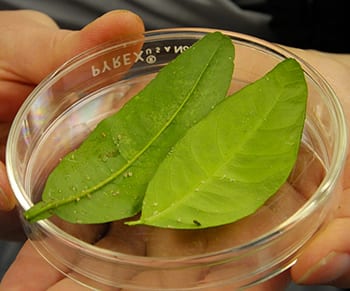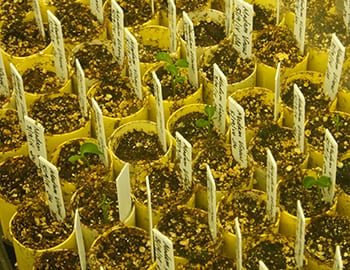News
Collaboration of Citrus Greening Researchers Begins 5-Year Plan to Save Citrus
A diverse group of researchers has teamed up to develop a therapeutic treatment for citrus greening disease, a bacterial infection that threatens the future of the U.S. citrus industry.
To kick off the initiative, the research team meets next week at the ninth annual Arthropod Genomics Symposium at Kansas State University in Manhattan, Kansas, June 17-19. The collaboration received a United States Department of Agriculture Specialty Crop Research Initiative grant worth $10 million to find a solution within five years.
“We have put together a strong team of researchers from eight institutions to combat this disease. We are taking a systems approach to bring newfound knowledge from our laboratory studies to the orchard quickly and safely,” said group leader Susan Brown of Kansas State.
Citrus greening disease is poised to decimate the U.S. citrus industry. The infection weakens and sometimes kills citrus trees and often causes small, unripe fruits. Though the disease has afflicted trees in Asia since the early 1900s, where it is called huanglongbing (HLB), the causative bacterium first surfaced in the U.S. in Florida in 2005. The plague has since permeated citrus groves throughout the state, where more than 70 percent of trees may be affected. Growers in Texas have already made isolated reports of infected trees.
A bacterial species called Candidatus Liberibacter asiaticus, or CLas, causes the infection and a sap-sucking insect called the Asian citrus psyllid spreads the bacterium as it feeds. Farmers have attempted to slow its advance through increased pesticide use, but this strategy has failed to stop it.
In an effort to block the transmission of CLas between trees, while curing existing infections, the researchers will use a comprehensive, multi-pronged approach that considers every gene, protein and metabolite within all three components of the problem: the bacterium, insect and citrus. Using proteomics, the study of every protein within an organism, genomics the study of all DNA in the genome, and metabolomics, the study of all metabolites, the researchers can find—and potentially block—interactions between specific molecules required to move the bacterium from tree to insect to tree.
Michelle Cilia of the Boyce Thompson Institute and a Research Molecular Biologist at the USDA Agricultural Research Service (ARS) in Ithaca, New York, with Robert Shatters, of the USDA ARS station in Fort Pierce, Florida and Professor John Lis of Cornell University in Ithaca are developing targeted therapies that will kill the Asian citrus psyllid when it feeds on the plant or will block the bacterium from colonizing the psyllid when it enters the gut.
“We are working under the assumption that specific molecular interactions are required for the psyllid to be able to ingest the bacterium and for the bacterium to move from the digestive tract to the insect salivary glands where it can be secreted through saliva into healthy plants,” said Shatters. By interfering with these interactions, it may be possible to stop the psyllid from carrying the bacterium.

Michelle Cilia of the Boyce Thompson Institute and a Research Molecular Biologist at the USDA Agricultural Research Service (ARS) in Ithaca, New York
Cilia will use proteomics approaches to identify key protein interactions that occur during transmission and will test resulting therapeutic compounds in the greenhouse. “These protein or RNA molecules can be delivered from within the tree so that the psyllids get these blockers as they’re feeding,” said Cilia.
To complement the protein and RNA approaches, Carolyn Slupsky of the University of California at Davis will use metabolomics technologies to track the wide variety of metabolites produced by the psyllid—with and without the bacterium—as well as metabolic changes that occur within the tree after infection. She will use these techniques for rapid detection and monitoring of the bacterial infection in the tree, which will accelerate the testing of therapeutic compounds. An infected tree can take up to a year to test positive for the bacterium with traditional testing methods, but newer approaches will cut that time down to a few months.
“We can detect very early changes in plant metabolism that are related to infection,” said Slupsky. “If the therapy is effective, then we can tell very quickly.”
To handle the masses of the “omics” data that the group will generate, bioinformaticists in the laboratory of Lukas Mueller at the Boyce Thompson Institute are building a citrus greening portal (http://citrusgreening.org/) that will visualize connections among the proteomic, metabolomic and genomic data from the bacterium, psyllid and citrus. Mueller’s group has experience building databases for individual organisms, such as cassava, but this is the first database that will link all three organisms involved in citrus greening.
“This is a higher level problem that goes across multiple organisms,” said bioinformatics analyst Surya Saha from the Mueller group. “We want to build new tools which can help people connect the interactions between genes, proteins and pathways across the bacterium, the insect and the citrus plant.”
Tom D’Elia, Christopher Baechle and Chad Calvert of Indian River State College in Fort Pierce, Florida will train students to identify genes and other elements in the psyllid genome, to create 2D and 3D graphics for the citrus greening portal and to mine the data to identify specific targets for the therapies. This training will encourage interdisciplinary interactions between biology and computer science students while developing skills in early-career scientists. Students from Kansas State and Cornell will also participate in annotating the psyllid genome.
The citrus greening portal will also make this data available to the public, and most importantly, to citrus growers. A vital component of the project will be reaching out to growers to give them a voice in deciding how the treatments are developed and applied. The citrus industry is deeply involved in finding a solution and has contributed large amounts of funding to support citrus greening research.
Wayne Hunter, also at the USDA ARS station in Fort Pierce, will tackle the problem with a systems biology approach. He’ll attempt to model the complex interactions between the genome, gene expression levels, proteins and organs that make up the psyllid, citrus plant and CLas. Previously, he led the group that produced the psyllid genome and transcriptome—sequences from all of the RNA molecules in the organism. He will also contribute the micro/CT scans of psyllids that he generated with Javier Alba-Tercedor of the University of Granada, in Spain. These scans produce 3D images of the insect, which users can manipulate in three planes, pop out individual organs, visualize important proteins and link to relevant scientific studies.
“The database interface will be one of the first that is trying to become an ‘easy’ interface between people at all levels—public, private industry, growers and researchers. It will also show data associations which would have been lost if you had to search multiple separate databases,” said Hunter.
 Once a treatment is discovered, Shatters and Hunter will develop an effective delivery method. Ideally, the compound could be applied to the tree and ingested by the psyllid. Previous attempts to inject antibiotics directly into the tree trunk—while successful—are laborious, expensive and cause damage after repeated applications.
Once a treatment is discovered, Shatters and Hunter will develop an effective delivery method. Ideally, the compound could be applied to the tree and ingested by the psyllid. Previous attempts to inject antibiotics directly into the tree trunk—while successful—are laborious, expensive and cause damage after repeated applications.
“We are putting a lot of effort into the development of novel application strategies and we are working closely with industry to promote rapid commercial development,” said Shatters.
In the long-term, researchers hope to create citrus varieties that are resistant to the infection, using biotechnological approaches. USDA ARS horticulturist and geneticist Ed Stover is already working on transgenic plants that will deliver a treatment to the psyllid through the phloem—the tubes that transport nutrients to all parts of the plant—where the psyllids feed.
“We are eager for new targets for transgenesis that are very specific to the HLB system,” said Stover. “It’s very exciting to bring all of these new technologies to bear on such an important problem.”
Also collaborating on the project are Michael MacCoss at the University of Washington in Seattle; Gautam Gupta at Los Alamos National Laboratory in New Mexico; Jason Ellis at Kansas State; Alexa Lamm, Joy Rumble and Ricky Telg at the University of Florida in Gainesville.
For updates on the project, see the Citrus Greening Community Facebook page and Twitter @citrusgreening.





